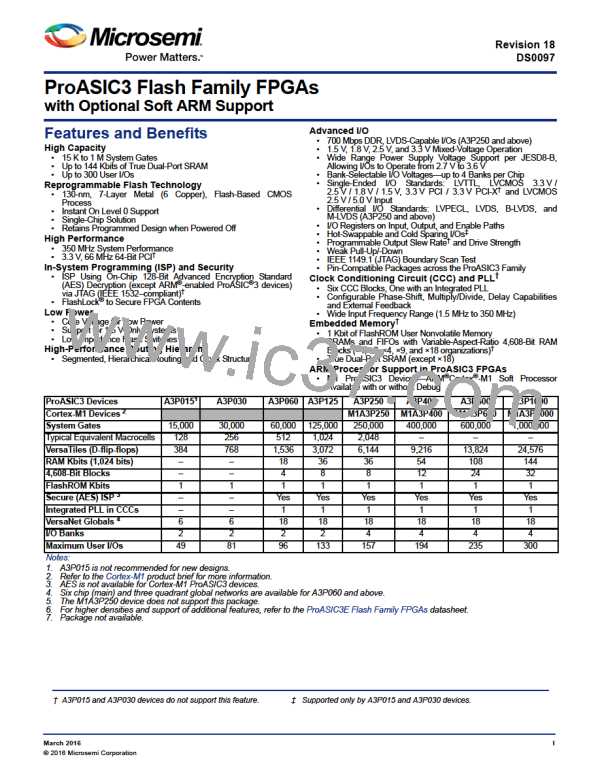ProASIC3 Flash Family FPGAs
Your valuable IP is protected with industry-standard security, making remote ISP possible. A ProASIC3 device
provides the best available security for programmable logic designs.
Single Chip
Flash-based FPGAs store their configuration information in on-chip flash cells. Once programmed, the configuration
data is an inherent part of the FPGA structure, and no external configuration data needs to be loaded at system power-
up (unlike SRAM-based FPGAs). Therefore, flash-based ProASIC3 FPGAs do not require system configuration
components such as EEPROMs or microcontrollers to load device configuration data. This reduces bill-of-materials
costs and PCB area, and increases security and system reliability.
Instant On
Flash-based ProASIC3 devices support Level 0 of the Instant On classification standard. This feature helps in system
component initialization, execution of critical tasks before the processor wakes up, setup and configuration of memory
blocks, clock generation, and bus activity management. The Instant On feature of flash-based ProASIC3 devices
greatly simplifies total system design and reduces total system cost, often eliminating the need for CPLDs and clock
generation PLLs that are used for these purposes in a system. In addition, glitches and brownouts in system power will
not corrupt the ProASIC3 device's flash configuration, and unlike SRAM-based FPGAs, the device will not have to be
reloaded when system power is restored. This enables the reduction or complete removal of the configuration PROM,
expensive voltage monitor, brownout detection, and clock generator devices from the PCB design. Flash-based
ProASIC3 devices simplify total system design and reduce cost and design risk while increasing system reliability and
improving system initialization time.
Firm Errors
Firm errors occur most commonly when high-energy neutrons, generated in the upper atmosphere, strike a
configuration cell of an SRAM FPGA. The energy of the collision can change the state of the configuration cell and
thus change the logic, routing, or I/O behavior in an unpredictable way. These errors are impossible to prevent in
SRAM FPGAs. The consequence of this type of error can be a complete system failure. Firm errors do not exist in the
configuration memory of ProASIC3 flash-based FPGAs. Once it is programmed, the flash cell configuration element of
ProASIC3 FPGAs cannot be altered by high-energy neutrons and is therefore immune to them. Recoverable (or soft)
errors occur in the user data SRAM of all FPGA devices. These can easily be mitigated by using error detection and
correction (EDAC) circuitry built into the FPGA fabric.
Low Power
Flash-based ProASIC3 devices exhibit power characteristics similar to an ASIC, making them an ideal choice for
power-sensitive applications. ProASIC3 devices have only a very limited power-on current surge and no high-current
transition period, both of which occur on many FPGAs.
ProASIC3 devices also have low dynamic power consumption to further maximize power savings.
Revision 18
1-2

 MICROSEMI [ Microsemi ]
MICROSEMI [ Microsemi ]